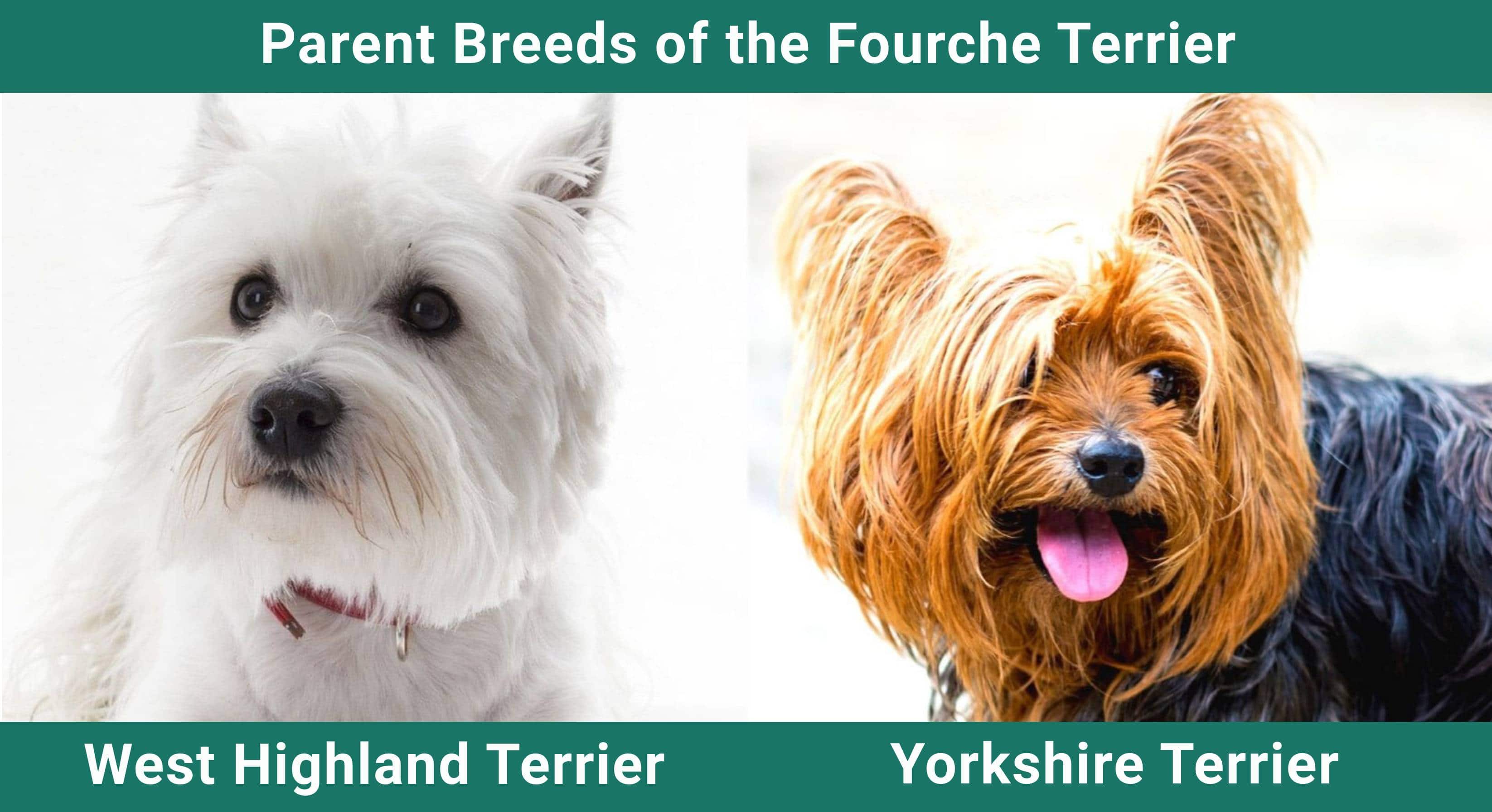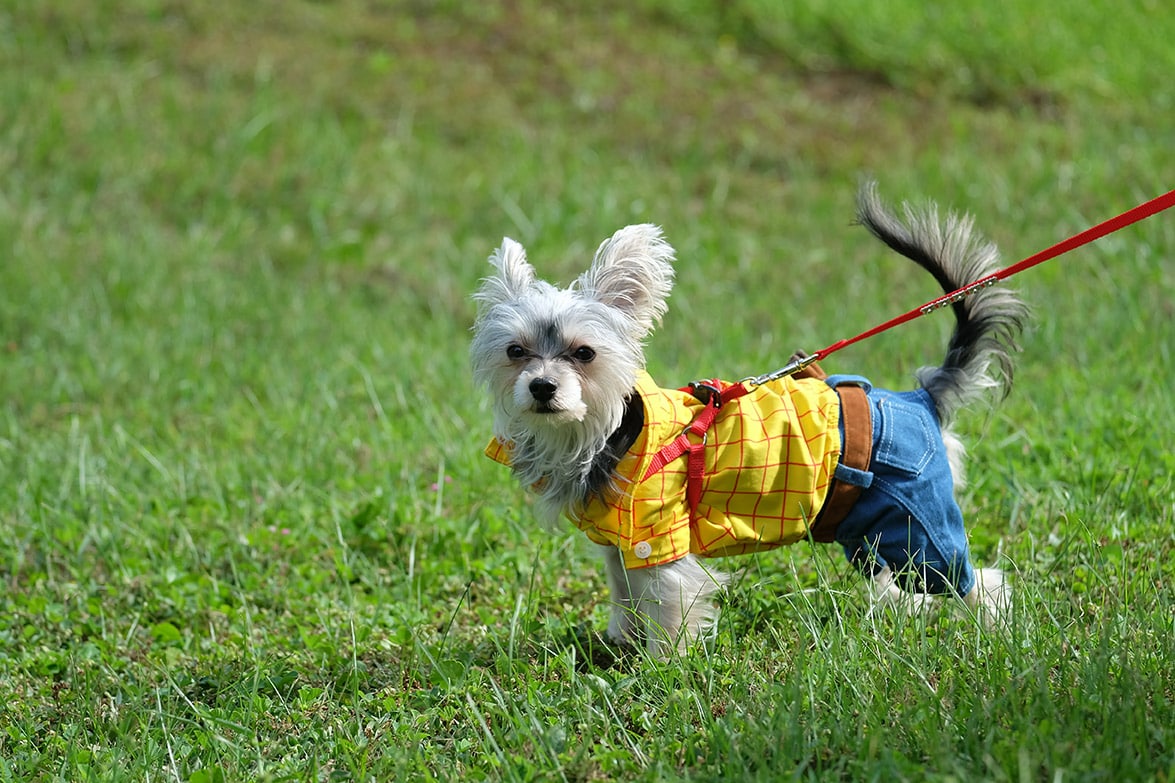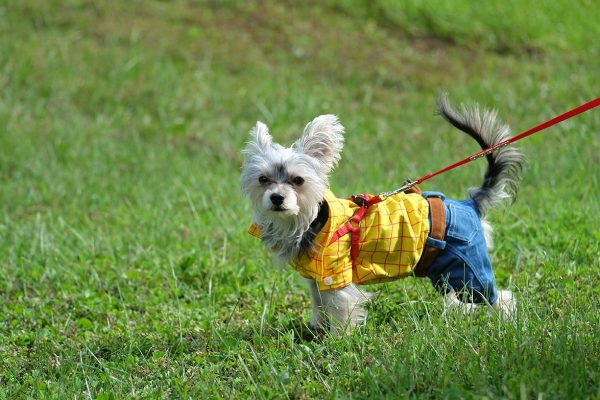Click Below to Skip Ahead
Though it may not sound like one at first glance, this terrier is a mixed breed. The Fourche Terrier is the result of mixing a West Highland White Terrier with a Yorkshire Terrier. They are also referred to as a “Yorke Westie,” though most breeders sell them as the Fourche Terrier.
Breed Overview
Height:
8-10 inches
Weight:
12-15 pounds
Lifespan:
12-16 years
Colors:
Nearly every color and combination
Suitable for:
Active families with old children; singles and couples looking for a small, active dog
Temperament:
Active, curious, devoted
This dog is a smaller breed that usually doesn’t get larger than about 13 pounds. Of course, some larger dogs do exist, but these are few and far between. They can be just about any color. They are typically not white, as this is a recessive color, and Yorkies are rarely carriers. This breed is known for its cheerful and alert nature, making them a good family dog.
However, because this breed is not purebred, you never know what you’re going to get. The Fourche Terrier can inherit any trait from either parent; you’re playing the dog lottery. You have to be willing to end up with a wide range of different appearance and temperament traits when adopting this breed.
Fourche Terrier Characteristics

Fourche Terrier Puppies
Fourche Terrier puppies are lively, curious, and confident and loves to play and explore. They are highly intelligent and eager to please, which makes them quick learners and great candidates for training. They are typically good with children and other pets, and they are known for their love of adventure and excitement. With proper training, socialization, and exercise, the Fourche Terrier can make a wonderful pet for the right family.
In most cases, this breed is either the result of an accidental litter or a breeder who is carefully trying to cultivate this mixed breed. Because this is not a purebred dog, it is rare to find a breeder specializing in them. You can expect to do quite a bit of searching before finding puppies for sale; they aren’t as common as purebred dogs. Puppies from accidental litters tend to be rarer than dogs from breeders, but they are also cheaper. Sometimes, these dogs may even be free. But they are usually lower-quality, as their owners often do not perform the proper health testing or get their puppies much vet care. These factors mean that you may be spending more in the long run on these dogs.

Temperament & Intelligence of the Fourche Terrier
Often, this breed of dog is friendly and active. Fourche Terriers are often quite yappy and alert, so we do not recommend them for those in search of a quiet dog. They are not laid back lap dogs by any means. Instead, you’ll spend much of your time playing with them and watching them run across the yard. They can be highly active, so be prepared before adopting them.
They are very devoted and bond closely with their family. However, this doesn’t necessarily mean that they are super trainable. They weren’t bred to listen to people. Instead, they’re working dogs that were designed to work alone. Following commands weren’t necessary.
Today, many of these dogs still aren’t very good at listening to their owners. They tend to be entirely independent, even if they are very devoted to their people. Consistent training is recommended, as are puppy training classes.
They are naturally suspicious of strangers, which drives some of their yappy behavior. They are very protective, though they are much too small to actually do anything. This distrust often leads to a lot of looking at the window and barking. They usually aren’t too friendly with strangers either and take a bit of time to warm up. We highly recommend early socialization to ensure that they understand that not all strangers are enemies. They make excellent watchdogs because of this behavior, though.
Some of these dogs are prone to separation anxiety. They may bond very closely to one person and become a bit protective of them. If this person leaves, they may become anxious and exhibit destructive behaviors.
Are These Dogs Good for Families?
We do recommend these dogs to families with older children. They aren’t necessarily great for families with younger children due to their smaller size. They are easily injured and may become scared of small children quickly. This fear may cause a lot of fear-based biting and snapping, which is decently common with smaller dogs. This fact is especially true due to their untrusting and protective nature.
They aren’t likely to tolerate a small child that moves around erratically.
However, they can be great for families with older children. They are decently active, so they do best for families that are active themselves. They will crawl up with a teen while they study or chase a middle schooler around the yard.
Some of them are one-people dogs, though, and these may be less suitable for families. Typically, these canines are less likely to bond closely with all members of the family. They’ll likely pick one person and follow them around.
Does This Breed Get Along with Other Pets?
Sometimes. When appropriately socialized, these dogs can be pretty friendly. However, they are also somewhat protective, which can get in the way of their relationship with other dogs. They are much more likely to see a strange dog in their home as a threat rather than a friend.
Of course, their smaller size means that they won’t be able to do much, especially if the other dog is larger. However, you can expect a lot of barking. When appropriately socialized, these dogs tend to be a bit more accepting. They are not going to be as friendly and laid back as other breeds, though.
When raised around another dog, they typically do perfectly fine with that dog. This doesn’t necessarily mean that they are great with all dogs, though. Introducing a new dog to your home can be a slow process.
They do have a high prey drive, so they aren’t good in homes with cats. They will chase the cat in most cases, even if they were socialized heavily with cats growing up. The only exception to this rule is smaller dogs and larger cats. If your Fourche Terrier is smaller, then they may not see larger cats as prey animals. This is a bit of a hit-or-miss, though.
Things to Know When Owning a Fourche Terrier
Food & Diet Requirements
These dogs do not have any particular dietary requirements. They can eat any high-quality commercial food. Due to their smaller size, it is a bit easier to feed them premium food, as they generally eat very little. We do recommend choosing the highest-quality food that you can find to support your dog’s overall health.
You should always follow the directions on the back of the bag when feeding your dog. Sticking to just the amount of food your dog needs is important to prevent obesity. While these dogs are not terribly prone to obesity, they can be affected if they eat too much or do not get enough exercise. Due to their small size, even a pound can make them more prone to a variety of health problems. Therefore, it is essential to keep an eye on their body condition.
They will often do best on a food designed for small breed dogs. This isn’t because they have special dietary requirements, but because they have small mouths and may require a smaller kibble size. Larger pieces may be harder for them to handle.
Exercise
Despite their smaller size, these dogs often need quite a bit of exercise. They are like tiny energizer bunnies and often surprise new owners with their high level of activity. They will spend much of the day running around. A fenced-in backyard is highly recommended, though these dogs typically respond very well to a recall command.
Due to their smaller size, they should not be allowed to wander without supervision (though they may really want to). They can easily become injured by other dogs and predators. Some may even be taken by birds. Therefore, you should always supervise them in a safe area.
You should plan on exercising these dogs at least a few times a day. A 30-minute walk in the morning and another at night may be the best option for most dogs. They may need another playtime in the middle of the day, especially when they are younger. Often, they only need moderate exercise. They don’t need to run as hard as some other breeds.
Like all dogs, they often like walks. However, they can also enjoy playing fetch and anything that involves chasing. They love to chase things. While this can be a bit troublesome when they’re trying to chase butterflies and dogs much larger than them, you can utilize this trait to wear them out without wearing yourself out. Most would chase balls for hours if you kept throwing them.
Thanks to their small size, they are typically rather easy to exercise. They don’t need very much room to run because they are simply very small. Many will get worn out from running up and down hills. If you have a long hall in your home, it can provide a great opportunity for exercise when the weather is bad.
Training
Training can go either way with this breed. Some of them are devoted to their families to such an extent that they’ll listen to just about everything you say. Others are a bit more stubborn and prefer to think independently.
For this reason, we highly recommend that you assume your dog is going to be difficult to train. This may not be the case at all. However, it is better to start with this assumption so that you can get your dog the appropriate classes—rather than needing to adjust later on and get your dog classes after they’re already grown. The period of puppyhood in a dog’s life is when they are most adaptable, so early training is important.
We recommend puppy classes, particularly for this breed. This will help them get the basics of training down, as well as help you iron out any kinks you may discover. Classes with other dogs also provide socialization, which is essential for this breed.
On top of regular training, you do need to focus on socialization to a great extent. These dogs get along much better with others after they have been socialized. Without proper socialization, they may see everyone as a threat.
Grooming ✂️
This canine’s coat can vary widely, depending on the traits they inherit from their parents. Some of them require more maintenance than others. It just depends on their genetics.
Most of the time, you’ll need to brush their coat every other day with a slicker brush or firm bristle brush. While they are not technically longhaired, their coat is very dense, and they shed a lot. Mats can occur in some dogs, depending on the texture of their fur. For this reason, you’ll often find yourself brushing them more often than you’d expect. They aren’t exactly low-maintenance dogs by any means.
You may need to invest in a professional groomer a few times a year, though this will also vary from dog to dog. Some dogs will require more professional grooming than others.
You shouldn’t have to bathe these dogs very often at all, especially if you keep up with a regular brushing routine. The brush will remove much of the excess dirt and dust from their coat, which goes a long way to keeping them clean. If you do need to bathe them, be sure to use shampoo for sensitive skin, as some of them are prone to skin conditions.
Like all dogs, you’ll need to trim their nails and brush their teeth. Periodontal disease is very serious and occurs most commonly in smaller dogs. This is largely due to them having less room in their mouth, which can cause the teeth to squish together. This breed may or may not be prone to periodontal disease, depending on the genetics they inherit.
Either way, most dogs have dental disease of some sort, and the easiest way to avoid this problem is by brushing their teeth regularly.
Health and Conditions
As a mixed breed, these canines are often healthier than other dogs. This is because they draw from a wider gene pool, making it less likely that they will inherit rare genetic conditions. These conditions are often more common in purebred dogs, as they are inheriting traits from a rather small gene pool. The odds that both parents will be carriers are much higher in this case.
Patellar luxation is one of the more common diseases that owners will need to worry about. This condition occurs when your dog’s knee cap doesn’t fit into their knee correctly. This is most common with smaller dogs. Because this breed is a smaller dog, they may be more likely to be affected by this condition.
Tracheal collapse is another condition that affects small dogs. Vets aren’t exactly sure why this disease occurs in some dogs and not others. However, it causes difficulty breathing and often needs surgery to correct. Therefore, it is one of the more expensive diseases that your dog may end up with.
They may also be prone to portosystemic shunt. This condition is completely genetic, so it can be avoided with the correct health testing (for the most part, at least). It occurs when the large vein that carries blood to the liver does not flow correctly, allowing the dirty blood to bypass the liver and reenter the system. This can cause stress on the organs, as the blood will usually contain harmful chemicals.
Craniomandibular osteopathy also affects this mixed breed. This is a bone disease that affects specific bones in a growing dog’s skull. Bone lesions form, which can cause all sorts of problems. The West Highland White Terrier is prone to this disease, which they can pass down to their mixed breed puppies on some occasions.
Though it is much less serious than other conditions we have mentioned, this breed may also develop seborrhea. This is a skin condition in dogs that causes the cornification of the outer layer of skin. The skin doesn’t wear away naturally like it is supposed to, so the excess skin slowly build-up over time. Typically, excessive oiliness and inflammation are also common. This condition does have an underlying genetic link.
Male vs Female
There is no significant difference between the males and females of this breed. Because they inherit from such a wide gene pool, they have little chance to develop the specific difference between genders. Males may be bigger, but their size varies so widely that this can often be difficult to tell.
What gender you choose is completely up to you. There isn’t much difference between their temperament, but dogs do tend to get along best with other dogs of the opposite gender. This may affect your decision if you already have another dog. If you don’t, there is little reason for you to choose one gender over the other.

3 Little-Known Facts About the Fourche Terrier
1. They aren’t purebred dogs
Sometimes, these dogs are mistaken for purebreds because they sound like they are. You would never guess that this breed is a mix between a West Highland White Terrier and a Yorkshire Terrier based on their name alone.
But this breed is absolutely a mixed breed. The Fourche Terrier is not recognized by any kennel club and is directly descended from two different purebred dogs.
2. Not all Fourche Terriers are good with children
Many people see these small, fluffy dogs and assume that they are good with children. However, this is not always the case. Their smaller size means that they are more likely to be injured by rough children, leading to fear-based biting. It isn’t odd for these dogs to be scared of children if they are not socialized appropriately.
3. Their trainability varies
Most of the time, these dogs are pretty stubborn. They often have a terrier’s stubbornness. Neither of their parent breeds is exceptionally trainable, and they both can be rather stubborn. However, some of them can be trained with some ease.
Final Thoughts
While it may not sound like a mixed breed, the Fourche Terrier is a mix between a Yorkie Terrier and West Highland White Terrier. These two terriers produce a rather active dog that also happens to be very fluffy and adorable.
Because they are a mixed breed, their appearance and temperament can vary quite a bit. This is important to keep in mind when deciding whether or not this is the breed for you. If you’re looking for a very specific dog, this breed probably isn’t the right one for you. You have to be prepared for some variance.
Overall, these dogs require a moderate amount of maintenance. Their coat will need moderate amounts of brushing, though this will depend on their coat length and texture. Their exercise needs are likely higher than you might imagine, as they are extremely active little dogs.
Be sure you’re prepared for this dog’s somewhat high needs before you adopt them. Just because they are fluffy and cute doesn’t mean that they are lap dogs.
Featured Image Credit: Panpilas L, Shutterstock








